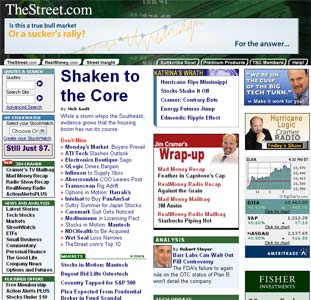
November 1996 – TheStreet.com begins running stories online after being founded by hedge fund manager James Cramer. It goes public in 1999.
TheStreet.com, which had been founded in November 1996 as an online financial information service. Within a year of its founding, the site had 3,500 members who were paying $12.95 per month to access its articles, and it was expanding its coverage to include company earnings and mutual funds. TheStreet.com was founded by hedge fund manager Jim Cramer, and he became the face of the fledgling business news site, but many didn’t consider him a business journalist even though he wrote a column on the site. Cramer’s in-your-face style was also seen on CNBC, and he had previously been a columnist for Smart Money, the investing magazine started by Dow Jones in 1992.
By the time the Web site went public in 1999, it had a staff of more than 50 reporters and editors and another two-dozen outside contributors, with more than 40 stories being posted every day. Reporters were motivated to break news with $2,000 bonuses. The subscriber base had grown to more than 37,000 by February 1999, and the site hoped to capitalize on the growth of online brokerage accounts, which were expected to grow from 3.5 million at the end of 1997 to 24 million by the end of 2002. In other words, TheStreet.com hoped to attract subscriptions from people who believed they could get rich playing the market. “The whole premise of Cramer’s financial writing was that he would bring the average Joe inside Wall Street and explain the intricacies of the game as he risked his own cash,” noted one observer. “That meant he had to be candid about his setbacks as well as his triumphs.” When the stock began trading in May 1999, it went from $19 to $71 in the first day, receiving a huge run-up similar to other Internet stocks that had gone public.
Cramer touted the immediacy that the Web site could offer to readers compared to magazines and newspapers that also included pages and pages of investment advice. “It’s impossible for magazines like Worth, Money, Smart Money to deliver a serious financial product at a time when other people can deliver information instantaneously,” he said. Although he might have been exaggerating, Cramer did have a point. Most financial magazines were printed days before they arrived in the hands of subscribers. During that time, a major news event such as a merger, acquisition, or executive shakeup could have affected a stock or an entire industry that was featured in the print publication.
Some thought Cramer used the Web site to boost the performance of his hedge fund by writing positively about stocks in which he was invested and trashing stocks that he had sold. The criticism hurt TheStreet.com’s credibility, and all Internet news sites struggled to build trust with readers as many considered them opportunistic operations.
The web site, however, did present some strong business journalism. Columnist Peter Eavis was one of the first to criticize Enron’s financial accounting, and he also was ahead of other business journalists in examining the problems at life insurer Conseco.